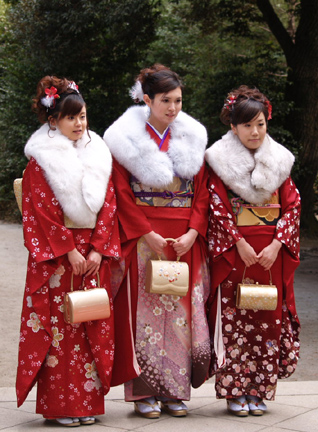-–убрики
- ‘ен-Ўуй (9)
- итайска€ кухн€ (5)
- ћастер-класс (4)
- ∆ивопись (4)
- ’удожники (2)
- аллиграфи€ (1)
- »з истории (1)
- Ѕлаговони€ (1)
- „айна€ церемони€ (0)
- итайска€ медицина (0)
- Ћирика и поэзи€ (0)
- ѕрирода (0)
-ѕодписка по e-mail
-ѕоиск по дневнику
-ѕосто€нные читатели
-—татистика
Ѕез заголовка |
»з дневника
It was the second Monday of January and once again Japan's new adults were out and about enjoying their new-found adulthood on the national holiday of Seijin-no-Hi: Coming of Age Day. Many young women sported decorative kimonos with the long-sleeves called furisode. While most young men wore suits, a few here and there wore the formal male kimono known as a hakama.

Japan especially likes marking the ages of its populace and Seijin-no-Hi is no exception. In November, the little ones are all decked out in pretty kimonos. Girls age 3 and 7 and boys age 5 are honored every year on the Shinto holiday, Shichi-Go-San. Another national holiday is Keiro-no-Hi, in September, which is Respect for Elders Day.

As for Seijin-no-Hi, the national holiday is only a little over half-a-century old having started in 1948. Now the focus is mainly on the young women in their stunning kimonos while the boys get second billing. In the past, however, the emphasis was on the boys. Young men had two coming of age celebrations in which they would change their names. At age 12 and 16, they would individually go through their own private special ceremonies. For samurai households, this was a big deal with much pomp and ceremony.




ѕроцитировано 1 раз
| омментировать | « ѕред. запись — дневнику — —лед. запись » | —траницы: [1] [Ќовые] |






